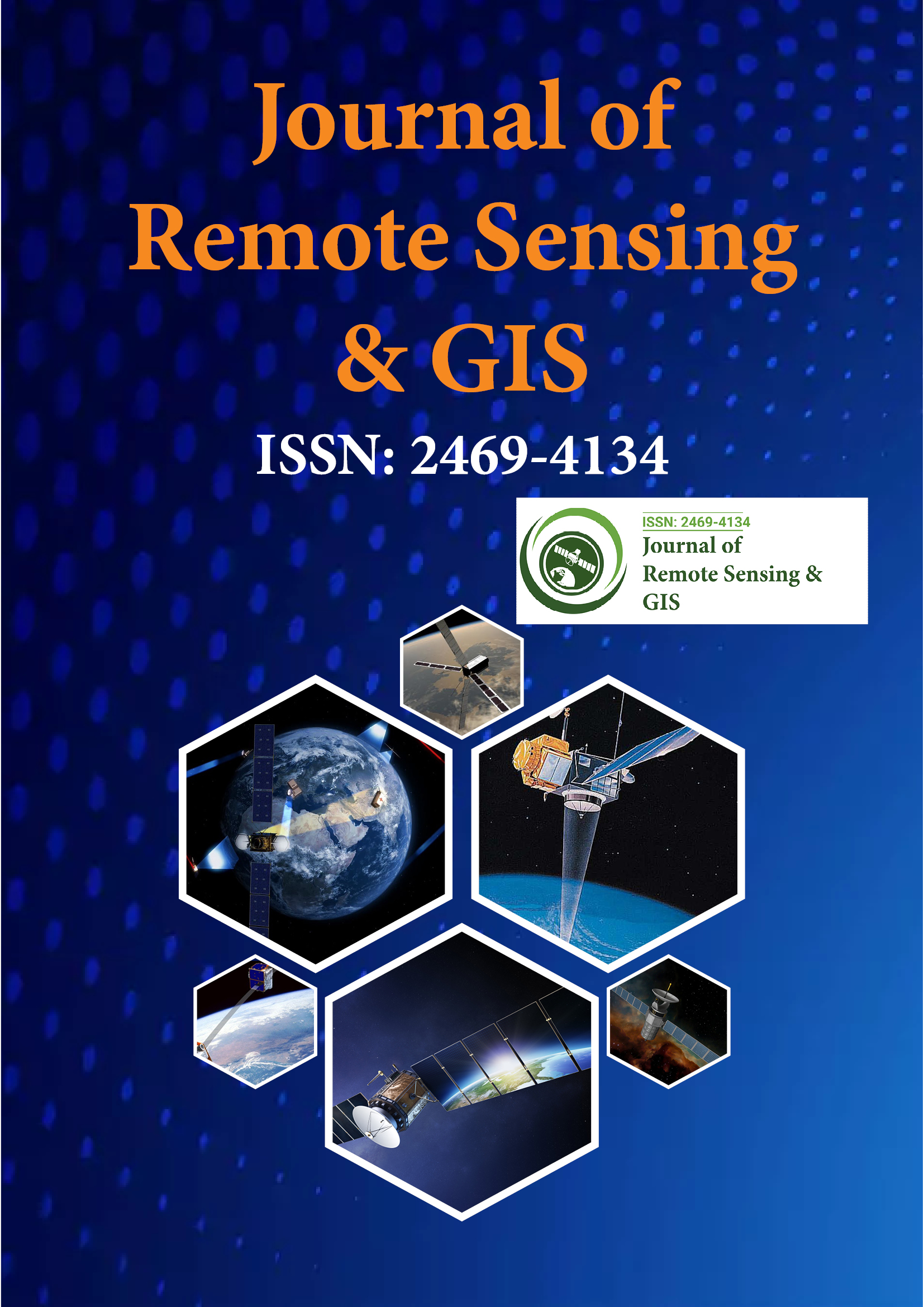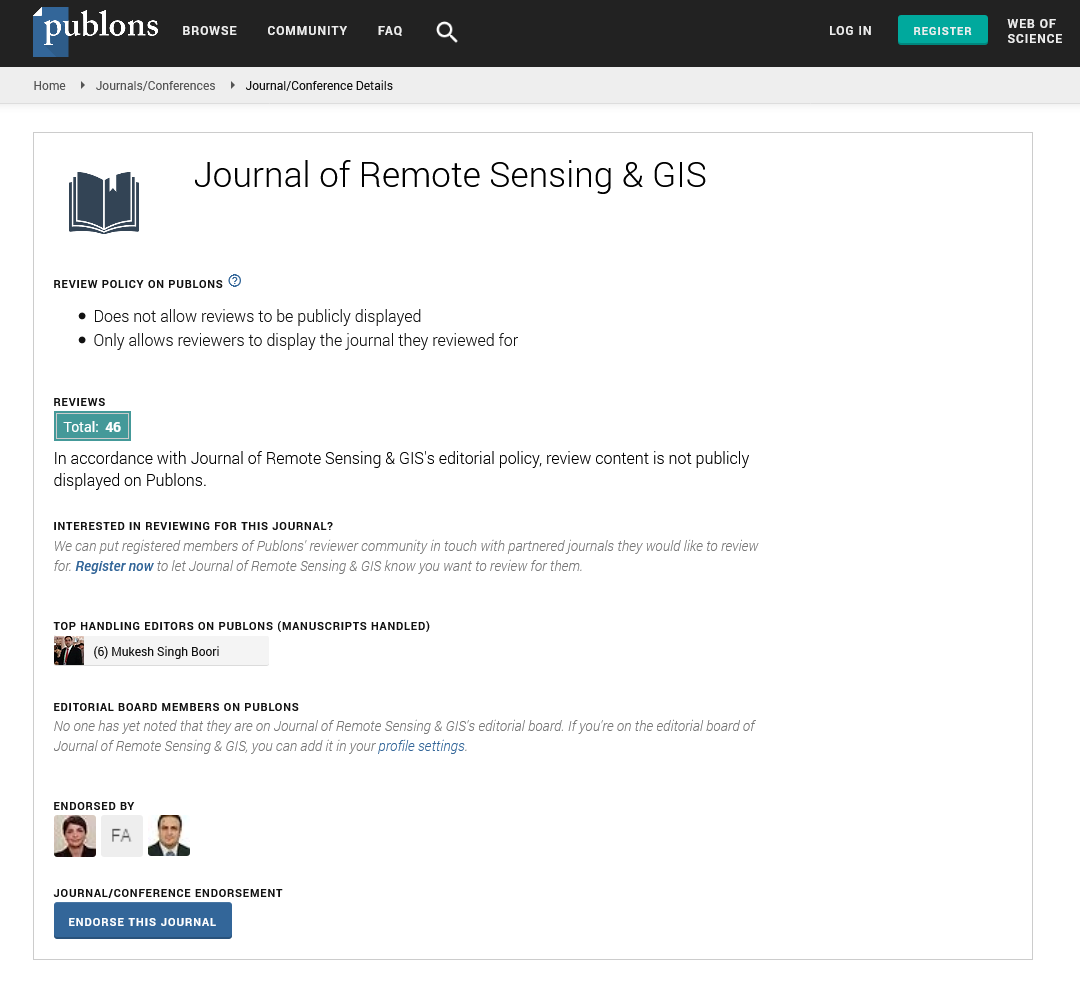Indexed In
- Open J Gate
- RefSeek
- Hamdard University
- EBSCO A-Z
- OCLC- WorldCat
- Publons
- International Scientific Indexing
- Euro Pub
- Google Scholar
Useful Links
Share This Page
Journal Flyer

Open Access Journals
- Agri and Aquaculture
- Biochemistry
- Bioinformatics & Systems Biology
- Business & Management
- Chemistry
- Clinical Sciences
- Engineering
- Food & Nutrition
- General Science
- Genetics & Molecular Biology
- Immunology & Microbiology
- Medical Sciences
- Neuroscience & Psychology
- Nursing & Health Care
- Pharmaceutical Sciences
Commentary - (2025) Volume 14, Issue 2
Remote Sensing for Deforestation Monitoring and Forest Management
Frank James*Received: 06-Jun-2025, Manuscript No. JGRS-25-29354; Editor assigned: 09-Jun-2025, Pre QC No. JGRS-25-29354 (PQ); Reviewed: 23-Jun-2025, QC No. JGRS-25-29354; Revised: 30-Jun-2025, Manuscript No. JGRS-25-29354 (R); Published: 07-Jul-2025, DOI: 10.35248/2469-4134.24.14.381
Description
The global decline of forest cover has emerged as one of the most pressing environmental concerns due to its implications for biodiversity, carbon cycling and climate regulation. Monitoring deforestation in real-time and over large areas poses a challenge when relying on traditional ground-based surveys. Remote sensing offers a powerful solution by enabling systematic observation of forest ecosystems using satellite and aerial data. The development of high-resolution imagery, combined with advances in data processing, has greatly improved the ability to detect changes in forest cover over time and guide management strategies.
Remote sensing techniques rely on the principle that different land cover types reflect and absorb electromagnetic radiation in distinct ways. Forested areas, in particular, exhibit strong reflectance in the near-infrared range due to the internal structure of healthy vegetation. By analyzing reflectance patterns across various spectral bands, it becomes possible to differentiate between dense forest, degraded land, plantations and non-vegetated surfaces. Multi-temporal imagery allows for comparison between different time periods, making it easier to identify changes caused by logging, fire, urban expansion, or agricultural encroachment.
One of the widely used satellite programs in forest monitoring is the Landsat series, which has been providing free imagery since the 1970s. With a spatial resolution of 30 meters and consistent revisit times, Landsat data supports long-term trend analysis. More recent missions like Sentinel-2, with a 10-meter resolution, have improved the granularity of observation. Very high-resolution commercial satellites, such as those in the PlanetScope constellation, enable detection of smaller disturbances that might not be visible in coarser data. These satellites contribute to both national forest inventories and international deforestation alert systems.
Remote sensing facilitates both qualitative and quantitative analysis. Visual interpretation of satellite images can provide insights into the type and pattern of deforestation, such as clear-cutting versus selective logging. Automated classification techniques using algorithms like supervised classification, random forest, or support vector machines enable the categorization of land cover types at scale. Normalized Difference Vegetation Index (NDVI) is frequently used as a metric to assess vegetation health and cover. Declining NDVI values over time often signal deforestation or forest degradation.
Change detection methodologies have become more sophisticated with the integration of time-series analysis and machine learning. By analyzing image stacks across multiple years, subtle trends in vegetation loss can be distinguished from seasonal variations. Cloud computing platforms such as Google Earth Engine have transformed accessibility to large-scale analysis, allowing users to run complex algorithms without the need for high-end local infrastructure. These tools have enabled researchers, government agencies and NGOs to track forest loss with greater precision and frequency.
Remote sensing is increasingly being integrated with forest management systems. For example, early-warning alerts based on satellite data can notify rangers of illegal logging activity in protected areas. Deforestation risk maps support targeted patrol planning and policy decisions on resource allocation. In regions prone to wildfires, satellite-derived vegetation dryness indicators help identify areas at greater risk and inform pre-emptive fire control measures. Forest health monitoring, including pest infestation and disease spread, also benefits from regular satellite surveillance.
The role of remote sensing extends beyond monitoring to support reforestation and conservation planning. Satellite imagery helps identify degraded lands suitable for restoration, monitor the progress of afforestation efforts and evaluate the success of interventions. Carbon offset programs rely on remote sensing data to quantify changes in forest biomass and validate carbon sequestration estimates. In countries participating in REDD+ (Reducing Emissions from Deforestation and Forest Degradation), satellite-based forest inventories are essential for reporting and verification.
Despite its capabilities, remote sensing for forest monitoring faces challenges. Cloud cover, especially in tropical regions, can limit the availability of optical data. Synthetic Aperture Radar (SAR) systems, such as those on Sentinel-1, address this by providing cloud-penetrating data that captures structural information on vegetation. Another limitation is the need for accurate ground-truth data to train and validate classification models. Field-based observations and GPS-tagged photographs are vital for improving the reliability of satellite-derived outputs.
The increasing availability of open-access satellite data, combined with the development of user-friendly processing tools, is expanding the reach of remote sensing applications. Local communities, indigenous groups and non-specialist stakeholders are now able to contribute to monitoring efforts using mobile tools that integrate satellite data with crowdsourced observations. This democratization of forest monitoring not only enhances data richness but also fosters accountability and transparency in forest governance.
In conclusion, remote sensing has transformed the way deforestation is monitored and forests are managed. By enabling consistent, large-scale and repeatable observations, satellite data supports timely detection of changes in forest cover and provides a foundation for data-driven decision-making. The integration of remote sensing with forest management systems enhances the ability to respond to threats, plan restoration and evaluate conservation outcomes. As technology continues to evolve, combining remote sensing with ground data and community engagement holds promise for more effective and inclusive forest stewardship.
Citation: James F (2025). Remote Sensing for Deforestation Monitoring and Forest Management. J Remote Sens GIS.14:381.
Copyright: © 2025 James F. This is an open-access article distributed under the terms of the Creative Commons Attribution License, which permits unrestricted use, distribution and reproduction in any medium, provided the original author and source are credited.

